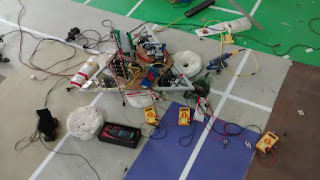Hey, I have been working on Robocon's statement for around 9 weeks. We are trying to develop a differential drive this time. If you had followed this blog from the past then you might be familiar with the way we have developed the three-wheel omniwheel driving chassis in the Summers. In a similar fashion we started to develop the differential driving model for the robot. The driving and the output of the robot was observed earlier this week and we were successful in developing an autonomous robot using line feedback. But the estimated linear velocity for the robot was lesser than expected. To increase the linear velocity of the robot we tried to,
1. Increase wheel diameter
2. Remove gears
3. Make a gear ratio of 1:1
Last night, I tried to drive the bigger wheel chassis. We would experience some harsh noise from the motors in this configuration. Upon checking up the lower control system, the graphs revealed something that I had not taken in account.
DISCLAIMER : All the tests mentioned are free wheel, i.e. wheels in air.
The wheel showed a good critically damped transient when given a step input from rest to say 200 RPM. It would run fine (a little sluggish than the small diameter ones but okay). But upon removing the step input, i.e. from non zero high RPM to low RPM, the graph would shoot down the zero line very abruptly, almost like a spike. This resulted in change of polarity at motor terminals in very short duration resulting in the harsh noise and might even result in permanent damage of motor.
The reason for this is yet being under study but the intuitive and logical reason behind this is the HIGH MOMENT OF INERTIA of the wheel. Omniwheels had their mass almost concentrated at center thereby rendering less inertia. The current wheels have high inertia due to mass at the periphery, hence even after removing output, the wheel tends to rotate resulting in the need of a brake to stop it, generated as a negative voltage from the PID controller. So I am gonna start working on the second approach to increase linear velocity of the robot for now. This hypothesis still needs to be verified. If verified, I would like to put a statement saying, "Choose low inertia and good traction wheels."
The gist of this post was to call out to all the control workers out there that even a change in wheel (no change in robot weight, dimension, orientation, motor, actuator) can mess up a lot in the system.
- Aniket
1. Increase wheel diameter
2. Remove gears
3. Make a gear ratio of 1:1
Last night, I tried to drive the bigger wheel chassis. We would experience some harsh noise from the motors in this configuration. Upon checking up the lower control system, the graphs revealed something that I had not taken in account.
DISCLAIMER : All the tests mentioned are free wheel, i.e. wheels in air.
The wheel showed a good critically damped transient when given a step input from rest to say 200 RPM. It would run fine (a little sluggish than the small diameter ones but okay). But upon removing the step input, i.e. from non zero high RPM to low RPM, the graph would shoot down the zero line very abruptly, almost like a spike. This resulted in change of polarity at motor terminals in very short duration resulting in the harsh noise and might even result in permanent damage of motor.
The reason for this is yet being under study but the intuitive and logical reason behind this is the HIGH MOMENT OF INERTIA of the wheel. Omniwheels had their mass almost concentrated at center thereby rendering less inertia. The current wheels have high inertia due to mass at the periphery, hence even after removing output, the wheel tends to rotate resulting in the need of a brake to stop it, generated as a negative voltage from the PID controller. So I am gonna start working on the second approach to increase linear velocity of the robot for now. This hypothesis still needs to be verified. If verified, I would like to put a statement saying, "Choose low inertia and good traction wheels."
The gist of this post was to call out to all the control workers out there that even a change in wheel (no change in robot weight, dimension, orientation, motor, actuator) can mess up a lot in the system.
- Aniket















